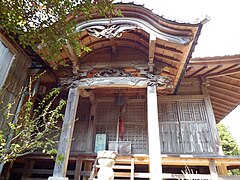Kongōchō-ji (Muroto)
The Kongōchō-ji ( Japanese 金剛 頂 寺 ), also called Nishi-dera (西 寺), with the Go Ryūzuzan (龍頭 山) and Kōmyōin (光明 院) in the city of Muroto ( Kōchi Prefecture ), is a temple belonging to Buzan -Direction (豊 山 派) of Shingon Buddhism belongs. In the traditional count, it is the 26th temple on the Shikoku pilgrimage route .
history
The Kongōchō-ji was built by priest Kūkai in 807 at the request of the emperors Saga and Junna . It was a high-ranking temple that owned large estates. According to records from 1070, the entire area belonged to the present-day city of Muroto. Later the area shrank somewhat, but was in the Edo period by the 2nd Prince of Tosa, Yamanouchi Tadayoshi (山 内 忠義; 1592–1692). The temple burned down in 1899, the current buildings date from the time after. As an esoteric temple steeped in history, the temple has many treasures.
investment
You climb a steep stone staircase to the temple, pass the temple gate (山門, Sammon; 1 in the plan), which is designed here as a Hakkyaku-mon (八 脚 門), i.e. a gate with 8 pillars. An oversized straw sandal is hung on each side. On the left one reaches the Daishidō (大師 堂; 2) via a parallel staircase, which is dedicated to the temple founder. Back on the main staircase you pass the bell tower (鐘楼, Shōrō; 3) and then reach the upper level. There the main hall (本 堂, Hondō; 4) is in front of it. Next to it is the treasure house (霊 宝殿, Reihōden; 5)
Below the temple complex is the quarters for pilgrims (西 寺 壇 信 従 会館, Nishidera-dan shinjū kaikan; Q) and the monks' quarters (金剛 頂 寺 本 坊, Kongōchō-ji hombō; M).
Treasures
The temple has numerous treasures related to esoteric Buddhism. All of the following treasures are registered as an Important Cultural Property of Japan :
- a standing Kannon figure made of copper (銅 造 観 音 菩薩 立 像, Dōzō Kannon bosatsu ritsu-zō) with a height from its pedestal of 29.1 cm. It is unusual for this area, dates from the Hakuhō period and is believed to have come here from central Japan.
- a seated figure of Amida (木造 阿 弥陀 如 来 坐像, Mokuzō Amida nyorai zazō), which dates from the late Heian period .
- the eight patriarchs of the Shingon Faith (板 彫 真言 八 祖, Itabori Shingon hasso). They are individually made from valuable Hinoki wood , 87.0 to 89.9 cm high, 56.5 to 61.6 cm wide and about 2.5 cm thick. This set of individual figures made of painted wood is unique in all of Japan. The figures are said to come from a no longer existing pagoda and are signed on the back with the year Karyaku 2 (1327).
- a copper bell (銅鐘, Dōshō) from Korea, which is dated to the 12th century. She will "Come on, rain! Fishing bell “(雨 ご い の 釣 鐘, Amagoi no tsurigane). The rural population is said to have dipped them into the sea to “fish” for rain.
- Cult items of esoteric Buddhism: large ritual objects (金剛 密 教法 具 Kongō mikkyōhō-gu) from the Kamakura period for the temple and smaller ones from the late Heian period for use when traveling (金剛 旅 壇 具, Kongō tabidan-gu).
- Sutras, the writing style from the later Heian period, the Daibiroshana Sutra (大比 盧 遮那 経) and the Kongōchō Sutra (金剛 頂 経).
photos
Remarks
- ↑ As Nishi-dera = "West Temple", the Kongōchō-ji stands across from the Hotsumisaki-ji as the "East Temple".
literature
- Kōchi-ken kotogakko kyoiku kenkyukai rekishi bukai (Ed.): Kongocho-ji . In: Kōchi-ken no rekishi sampo. Yamakawa Shuppan, 2006. ISBN 978-4-634-24639-3 . Page 206.
- Oguri, Doei: Kukai. Shikoku hachijuhachi kosho no arukikata. Chukei no Bunko, 2011. ISBN 978-4-8061-4067-2 .
Web links
Coordinates: 33 ° 18 '26 " N , 134 ° 7' 22.3" E
← Previous Temple: Shinshō-ji | Kongōchō-ji (Muroto) | Next temple: Kōnomine-ji →






